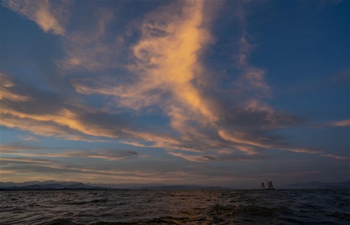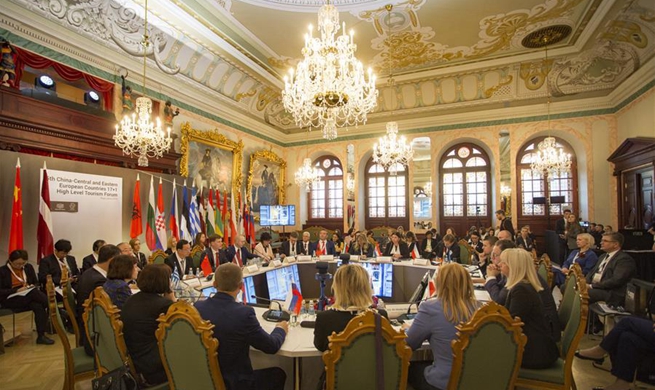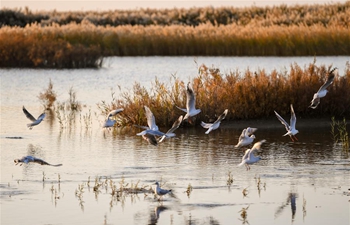BERGEN, Norway Oct. 24 (Xinhua) -- "I am very glad that demand for Norwegian seafood is increasing in China," said Sigve Dronen, operation manager of a fishing boat that belongs to Leroy, one of the biggest Norwegian seafood producers.
"We need a stable market. We need to know that we can sell the fish in the market that needs the food. Of course, this is very important for all of us," he told a group of Chinese reporters visiting the vessel docked near Bergen, a city on the west coast of Norway.
The seafood industry is the fastest growing sector among the three-pillar (petroleum, maritime and seafood) ocean industries in Norway. Like offshore energy and maritime industry, the seafood industry is highly dependent on exports, and it is vital to explore and maintain its international market share.
"Without a market, we have a lot of fish we can't eat because there are not enough people in Norway," said Dronen.
Export of Norwegian seafood to China has been growing in recent years. China is now this industry's third largest market after Denmark and Poland.
By the end of September, Norway's seafood exports to China this year had totaled nearly 112,000 tons, growing by 14 percent year-on-year and reaching 3.6 billion Norwegian kroner (395 million U.S. dollars). This year, China became the largest growing market for Norwegian seafood.
The most popular Norwegian seafood product is Atlantic salmon, followed by Arctic cod and mackerel, according to the Norwegian Seafood Council (NSC), the approval authority and official promoter for Norwegian seafood exporters.
According to Hans Petter Vestre, team manager of Leroy's Airborne Seafood Division, the relationship between Norway and China is quite good. "We feel that it's getting better every year. So I'm very optimistic that we can develop that," he said.
Vestre said he hoped that the ongoing negotiations about a free trade agreement between the two countries could progress and an agreement would be reached soon. "That would be a great achievement for Norway."
Vestre noted that there has been a strong demand for fresh salmon, especially in the Asian market. Because of its good quality and high safety standards, Atlantic salmon has become a favored ingredient for sushi and sashimi, he explained.
SALMON FARMING
Norway is the world's largest producer and exporter of Atlantic salmon. In 2018, the country produced 1.28 million tons of Atlantic salmon with the sales value of 64.58 billion Norwegian kroner (7.06 billion U.S. dollars). The amount is ten times higher than in 1990s, thanks to the advanced farming techniques.
Norwegians have been farming salmon since the 1970s, instead of depending totally on wild catch. There are hundreds of salmon farms in the fjords nowadays, covering 0.5 percent of the Norwegian waters.
Simultaneously with the increase in turnover, fish farmers have also enjoyed greater productivity. Around 1.2 kilogram of fish feed is required to produce one kilogram of farmed salmon, while a wild salmon needs up to 10 kilograms of food to put on one kilogram of weight, according to the NSC.
Jorgen Viksund, staff member of Blom fish farming company, told Xinhua that he would like to see the capacity of his company increase, considering that the country's exports to China are continuing to rise.
He admitted, though, that Blom was not applying for more farming licenses as under Norway's strict regulations the number of licenses granted should match the carrying capacity of the ecosystem.
"China is a key market for Norwegian seafood today ... and we definitely hope to be able to increase seafood collaboration," said Victoria Braathen, China director at the NSC.
Braathen stressed that the sustainability issue is at the core of seafood production, be it wild caught fishery or aquaculture production led by Norwegian salmon. "While we very much welcome an increasing demand for Norwegian seafood, when we produce seafood it has to be sustainable."
Norway's strategy for its ocean industries shows that global demand for seafood will increase with population growth. The country's marine industry has the potential to increase its revenues six-fold by 2050, reaching 550 billion Norwegian kroner in total.
The major challenge would be to turn out more valuable seafood products while at the same time maintaining the sustainability of marine resources. As the fishery resources have been almost fully utilized, more advanced technologies and better organized aquaculture will be the keys for growth. (1 Norway Kroner = 0.11 U.S. dollars)













